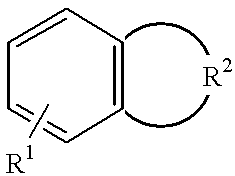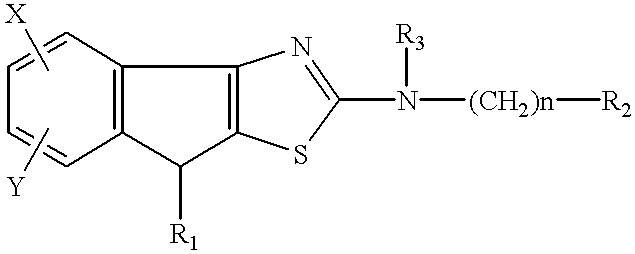Tricyclic compounds, their production and use
a technology of tricyclic compounds and tricyclic amines, applied in the field of tricyclic compounds, can solve the problems of unavoidably provoking adverse drug reactions, unadjustable affinity for pgi.sub.2, and insufficient chemical and biological stability of pgi.sub.2, and no information is available on the relation of known tricyclic compounds to the affinity of pgi.sub.2 receptors
- Summary
- Abstract
- Description
- Claims
- Application Information
AI Technical Summary
Benefits of technology
Problems solved by technology
Method used
Image
Examples
reference example 1
Ethyl[(5,6,7,8-tetrahydro-5-oxo-1-naphthalenyl)oxy]acetate
To a solution of 3,4-dihydro-5-hydroxy-1(2H)-naphthalenone (8.20 g, 50.6 mmol) in N,N-dimethylformamide (80 mL) was added sodium hydride (60% dispersion in liquid paraffin, 2.22 g, 55.6 mmol) at 0.degree. C. and the mixture was stirred at that temperature for 10 minutes. Then, ethyl bromoacetate (9.29 g, 55.6 mmol) was added and the mixture was further stirred at room temperature for 30 minutes. This reaction mixture was poured in water (80 mL) and extracted with 2 portions of ethyl acetate. The organic layers were pooled, washed with water, dried over anhydrous magnesium sulfate (MgSO.sub.4), and filtered, and the filtrate was concentrated under reduced pressure. The residue was crystallized from hexane-diisopropyl ether to provide 8.40 g of the title compound. Yield 67%.
m.p. 58-60.degree. C.
.sup.1 H-NMR (CDCl.sub.3) .delta.: 1.30 (3H, t, J=7.2 Hz), 2.04-2.23 (2H, m), 2.60-2.71 (2H, m), 3.00 (2H, t, J=6.2 Hz), 4.28 (2H, q, J...
reference example 2
Ethyl[(2,3-dihydro-1-oxo-1H-inden-4-yl)oxy]acetate
Using 2,3-dihydro-4-hydroxy-1H-inden-1-one, the procedure of Reference Example 1 was otherwise repeated to synthesize the title compound. Yield 70%.
m.p. 91-93.degree. C. (hexane-diisopropyl ether)
.sup.1 H-NMR (CDCl.sub.3) .delta.: 1.31 (3H, t, J=7.2 Hz), 2.66-2.74 (2H, m), 3.10-3.18 (2H, m), 4.28 (2H, q, J=7.2 Hz), 4.73 (2H, s), 6.92 (1H, dd, J=7.6, 1.0 Hz), 7.26-7.44 (2H, m).
reference example 3
Ethyl[(5,6,7,8-tetrahydro-5-oxo-2-naphthalenyl)oxy]acetate
Using 3,4-dihydro-6-hydroxy-1(2H)-naphthalene, the procedure of Reference Example 1 was otherwise repeated to synthesize the title compound. Yield 89%.
m.p. 39-41.degree. C. (hexane-diisopropyl ether)
.sup.1 H-NMR (CDCl.sub.3) .delta.: 1.31 (3H, t, J=7.4 Hz), 2.03-2.21 (2H, m), 2.57-2.66 (2H, m), 2.87-2.96 (2H, m), 4.29 (2H, q, J=7.4 Hz), 4.68 (2H, s), 6.73 (1H, d, J=2.4 Hz), 6.82 (1H, dd, J=8.8, 2.6 Hz), 8.02 (1H, dd, J=8.8, 2.6 Hz).
PUM
| Property | Measurement | Unit |
|---|---|---|
| Electric charge | aaaaa | aaaaa |
| Electric charge | aaaaa | aaaaa |
| Molar density | aaaaa | aaaaa |
Abstract
Description
Claims
Application Information
 Login to View More
Login to View More - R&D
- Intellectual Property
- Life Sciences
- Materials
- Tech Scout
- Unparalleled Data Quality
- Higher Quality Content
- 60% Fewer Hallucinations
Browse by: Latest US Patents, China's latest patents, Technical Efficacy Thesaurus, Application Domain, Technology Topic, Popular Technical Reports.
© 2025 PatSnap. All rights reserved.Legal|Privacy policy|Modern Slavery Act Transparency Statement|Sitemap|About US| Contact US: help@patsnap.com



